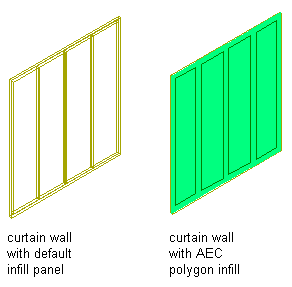An AEC polygon is a two-dimensional (2D) area object that can be used as infill for structures such as curtain walls and layout grids. You can use a True Color display representation to assign a solid fill to the edges and interiors of AEC polygons, making these objects useful for conceptual rendering.
AEC Polygons and Curtain Walls
Curtain walls provide a framework for inserting objects such as panels, windows, and doors. You can use curtain walls to model structures such as the following:
- Large scale curtain walls
- Storefronts with components
- Assemblies of custom-shaped doors and windows
In AutoCAD Architecture 2024 toolset, a curtain wall object consists of one or more grids. Each grid contains cells that can be filled by a panel, or by an object such as a window or door. AEC polygons are ideally suited to create panel infills for curtain walls.

A curtain wall can include curtain wall units. Curtain wall units are similar to curtain walls except that their grid cells can contain only panel infills, and not objects. Curtain wall units are designed to represent complex elements that are repeated within the main curtain wall. You can use AEC polygons to fill the grids in a curtain wall unit.
Paving and Tiling Patterns
You can use AEC polygons to create intricate paving and tiling patterns in a drawing. Using the join, subtract, trim, and split functions of AEC polygons, and by creating AEC polygons from profiles and polylines, you can create complex and irregular polygon outlines. By adding edges and hatch patterns to the AEC polygons, you can display a realistic tiling and paving look.